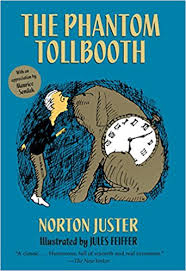The Phantom Tollbooth
Listen to the Recess! Clip
| Author | Ramona Caponegro |
| Air Date | 10/5/2006 |

The Phantom Tollbooth Transcript
My introduction to The Phantom Tollbooth by Norton Juster occurred when I was in the sixth grade, after my English teacher recommended the book as “a good read.” Following his suggestion, I accompanied the protagonist, Milo, past the magical tollbooth and into the “lands beyond.” There, Milo and his two sidekicks–Tock, a watchdog with the best traits of both canine and timekeeper, and Humbug, a blustery but well-intentioned fellow–embark on a mission to rescue the princesses Rhyme and Reason in order to restore balance and harmony in the Kingdom of Wisdom. The kingdom has been bitterly divided between two brothers, Azaz the Unabridged and the Mathemagician, with their respective kingdoms of Dictionopolis, the city of words, and Digitopolis, the city of numbers. The brothers once battled the demons of ignorance, but they now only battle one another over the presumed superiority of their respective domains’ currencies, words and numbers.
As Milo, Tock, and the Humbug search for the Castle in the Air, where Rhyme and Reason have been imprisoned, many of the everyday lessons and platitudes that are passed down from generation to generation, like “Use your time wisely,” “Look before you leap,” “Only speak when you have something to say,” and “Appreciate the little things,” come to life in the characters and settings around them. For example, when Milo and his traveling companions accept their own assumptions as facts, they unintentionally jump onto the Island of Conclusions. Likewise, Chroma, the conductor of color, and the Soundkeeper, whose favorite sound is actually silence, remind Milo and his friends that achieving beauty in both sight and sound is a matter of aesthetic balance that can never be taken for granted.
Since its initial publication in 1961, The Phantom Tollbooth has enchanted millions of readers with its droll sense of humor and its sharp wit. Norton Juster’s use of puns and wordplay allows something new to be discovered with each reading, and Jules Feiffer’s ink illustrations compliment the text beautifully. As my sixth teacher said, The Phantom Tollbooth is “a good read,” and, as the Duke of Definition, the Minister of Meaning, the Earl of Essence, the Count of Connotation, and the Undersecretary of Understanding would add, it is also great, outstanding, excellent, fantastic, and amazing.
Source:
Juster, Norton. The Phantom Tollbooth. New York: Bullseye Books, 1961.